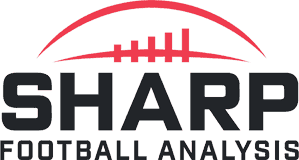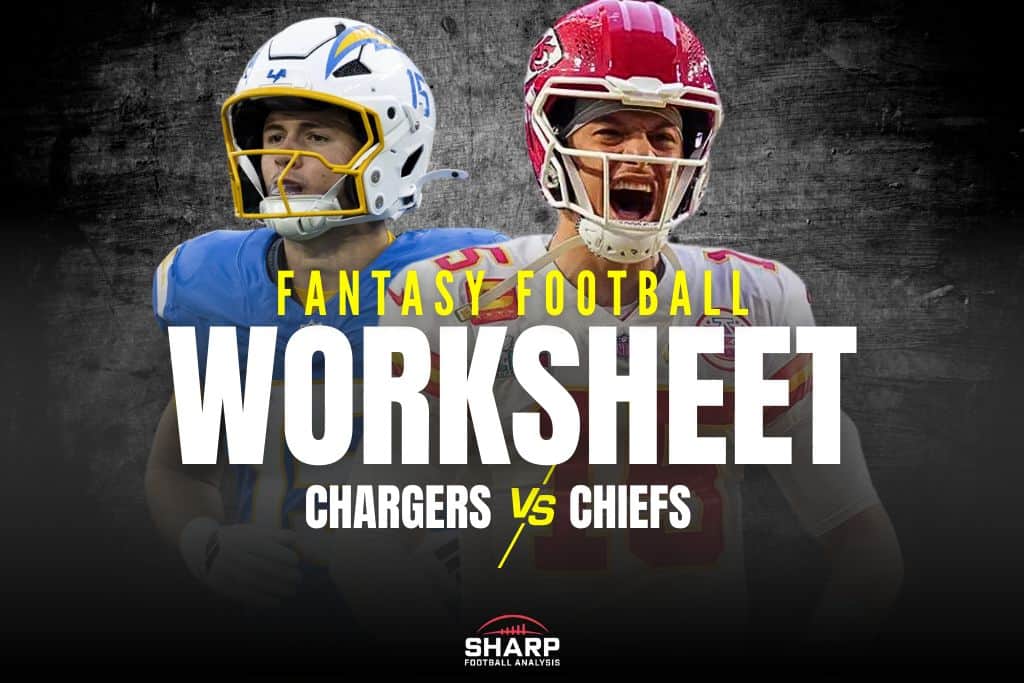The Worksheet, a comprehensive fantasy football preview by Rich Hribar, breaks down everything you need to know about the Week 1 matchup between the Chiefs and Chargers on Friday night.
Find a breakdown of every Week 1 NFL game in our Worksheet Hub.
| Kansas City | Rank | @ | LA Chargers | Rank |
|---|---|---|---|---|
| -3.0 | Spread | 3.0 | ||
| 24.25 | Implied Total | 21.25 | ||
| 23.1 | 12 | Points/Gm | 23.0 | 13 |
| 20.5 | 6 | Points All./Gm | 18.5 | 2 |
| 62.7 | 11 | Plays/Gm | 59.5 | 29 |
| 61.5 | 14 | Opp. Plays/Gm | 61.5 | 16 |
| 5.1 | 22 | Off. Yards/Play | 5.4 | 16 |
| 5.3 | 12 | Def. Yards/Play | 5.4 | 13 |
| 41.34% | 23 | Rush% | 44.91% | 10 |
| 58.66% | 10 | Pass% | 55.09% | 23 |
| 42.64% | 14 | Opp. Rush % | 41.55% | 8 |
| 57.36% | 19 | Opp. Pass % | 58.45% | 25 |
- The Chiefs have won seven consecutive games against the Chargers, the longest active winning streak against Los Angeles.
- The Chargers are 0-11 as an underdog in the past two seasons and 1-16 over the past three years.
- The Chargers were the league-best 12-4-1 against the spread in 2024.
- Charger games averaged 41.4 combined points in 2024, 29th in the league.
- Kansas City games averaged 41.8 combined points last season, 26th.
- The Chiefs scored a touchdown on 3 of 20 possessions against the Chargers in 2024.
- The Chargers scored a touchdown on 3 of 19 possessions against the Chiefs in 2024.
- The Chargers turned the ball over on a league-low 4.4% of their possessions last season. The league average was 10.7%.
- Kansas City had a league-low 17 runs of 10 or more yards from its running backs in 2024.
- The Chiefs have scored 6 (28th), 4 (30th), and 9 (13th) touchdowns from outside the red zone over the past three seasons after scoring 12 (7th), 17 (1st), and 21 (1st) touchdowns in the same area over the previous three years.
Trust = spike production for that player
Quarterback
Patrick Mahomes: After finishing as a top-six scorer every season from 2018 to 2022, Mahomes has closed the past two years as QB14 and QB13 in points per game.
Mahomes set career lows in passing yards per game (245.5) and yards per pass attempt (6.8) in 2024.
He threw 26 passing touchdowns over 16 games, matching a career low in 2019 when he played 14 games.
Mahomes threw 30.8% of his passes at or behind the line of scrimmage (only ahead of Tua Tagovailoa), his highest rate ever in a season.
Only 26.3% of his throws were 10 or more yards downfield (ahead of only Gardner Minshew), his lowest career rate.
The state of the Kansas City offensive line was its worst since the Tampa Bay Super Bowl.
Mahomes took a career-high 36 sacks.
He was hit on 108 dropbacks this past season, the most in his career.
To work around the cap and reshape the offensive line, the team used a first-round pick on left tackle Josh Simmons while adding swing tackle Jaylon Moore in free agency.
They did lose veteran Joe Thuney as part of an attempt to save money and give an extension to Trey Smith.
For as lackluster as his top-down stats look compared to his early career production, Mahomes closed the year strongly.
He threw 18 touchdowns to 2 interceptions over his final nine games.
Mahomes was QB2 in expected points per game from Week 9 on and delivered five QB1 scoring weeks.
That said, Mahomes was not electric in this matchup a year ago.
He was QB18 (13.0 points) and QB16 (14.1 points) in his two outings against the Chargers last year, throwing for only 6.9 yards per pass attempt in those games.
The Chargers were fifth in passing points allowed per game (12.7).
You did not just draft Mahomes as mid-round QB1 to bench him in Week 1, but he is more of a fringe starting option to open the season.
The suspension of Rashee Rice also means we are without a weapon here.
There has been a lot of talk out of Kansas City about getting the vertical passing game back on track this season.
Over the past two seasons, Mahomes is 29th in the NFL in rating on throws 10 or more yards downfield (72.1), ahead of only Caleb Williams, Sam Howell, Bryce Young, Daniel Jones, and Mac Jones among qualifying quarterbacks.
On those attempts, Mahomes has completed 47.7% of his passes (18th) for 9 touchdowns (26th) and 17 interceptions (32nd).
From 2019 to 2022, he had a 103.4 rating on those passes, which was eighth in the league.
We can also see this field having an impact, as it did a year ago.
Last year, the footing at Neo Quimica Arena was sloppy, which aided a plethora of splash plays.
That game featured 27 plays of 10 or more yards and 12 plays of 20 or more yards.
Justin Herbert: We entered last season expecting Herbert to have his best season from an efficiency standpoint while compromising on counting stats under Jim Harbaugh and Greg Roman.
That played out as expected.
Herbert threw for a career-low 227.6 yards per game, but he set career-best marks in interception rate (0.6%), yards per pass attempt (7.7), and yards per completion (11.7).
He was 12th among all quarterbacks in EPA per dropback (0.10), his highest mark since 2021.
He rushed for a career-high 306 yards last year.
While the conservative nature of this offense muted some of his top-down statistics, the Chargers opened things up along the way, which propelled Herbert to more fantasy success.
From Week 8 onward, the Chargers threw the ball 1% more than expected.
That was not groundbreaking, but they had been 5% below expectations up until that point in the season.
They had a 60.2% dropback rate (20th) after a 52% rate (29th) prior.
From then on, Herbert averaged 8.0 Y/A (6th) and 12.0 yards per completion (7th) with a 5.0% touchdown rate (14th) after he averaged 7.1 Y/A (19th), 10.9 yards per completion (18th), and a 3.7% touchdown rate (20th) prior.
The team generated splash plays, averaging 4.2 completions of 20 or more yards per game during that spike (7th in the league) compared to 3.2 per game beforehand (20th).
As a result, Herbert averaged 15.7 fantasy points per game over that stretch compared to 11.4 per game before.
He went from a back-end QB2 for fantasy to working his way into the back-end QB1 mix.
Harbaugh and Roman used pre-snap motion on 59.5% of Herbert’s dropbacks (8th) while he used play action on 32.1% (3rd).
Will the Chargers continue those tendencies to close the season, or was that spike in passing output due to a struggling run game?
That is what we will find out to open the year.
We know Harbaugh and Roman want an effective run game, and their primary moves this offseason have signaled an emphasis on refocusing on establishing the run better in 2025.
The team signed Mekhi Becton in free agency.
Then, they used the No. 22 pick on Omarion Hampton in the NFL Draft.
However, they also lost left tackle Rashawn Slater for the season.
The Chargers ran 159 plays last season with Slater off the field, averaging 4.8 yards per play (which would have ranked 27th) with a 37.9% success rate (29th) on those plays.
One of those games was against the Chiefs in Week 4, when they were also missing Joe Alt.
They at least have Alt to slide over to left tackle, moving Trey Pipkins in at right tackle.
When Slater missed Week 18 against the Raiders, the Chargers were able to slide Alt to left tackle and move Pipkins into right tackle, and they had much more success than earlier in the season.
This is still a tough assignment for Herbert if he's being pushed as more than QB2.
In his two outings against the Chiefs last year, he was QB23 (11.2 points) and QB19 (13.7 points) in weekly scoring.
To be fair to Herbert, he was missing both of his starting tackles in the first matchup and Ladd McConkey in the second matchup.
However, Herbert has thrown more than 2 touchdown passes in just one of his past six games against a Steve Spagnuolo defense.
Running Back
Omarion Hampton: Hampton has a three-down profile to be an NFL workhorse.
If you were building a running back, he would have the physical profile of Hampton, who helped his cause tremendously at the NFL Combine.
At 5-foot-11 and 221 pounds, Hampton ran a 4.46 40-yard dash (87th percentile adjusted for weight) while posting a 96th percentile explosion score (vertical plus broad jump) in the jumping drills.
The Chargers needed to revamp this backfield.
Their running backs combined for 1,514 yards on the ground (17th) but posted a 36.2% success rate (23rd), while 20.9% of their runs failed to gain yardage (28th).
There are few wrinkles here that lead me to handling Hampton as a touchdown-dependent RB2 in the season opener, however.
Najee Harris is expected to be active, although his playing time in a complete toss-up.
I do believe that Hampton has the best odds at leading this backfield, but Harris still has an impact on things.
Over the entire offseason, Greg Roman has talked about a split backfield and using both backs.
When the Ravens drafted J.K. Dobbins in the second round (55th overall) in 2020, Roman still used a 50/50 split between Dobbins and Edwards while sprinkling in a 31-year-old Mark Ingram.
Harris may not be the most electric running back, but he is reliable enough, with a work ethic that can earn him enough snaps to be a nuisance to gamers spending capital on Hampton.
We also have the potential impact of Rashawn Slater being out.
As mentioned earlier, the Chargers struggled without Slater, which impacted the run game.
Their backs averaged 3.2 yards per carry without him on the field.
This is also a matchup that could be on the tougher side.
The Chiefs were an aggressive run defense last season, allowing a league-low 3.8 yards per rush to running backs.
Only 19.3% of the running back runs against the Chiefs resulted in a first down or touchdown (5th).
Kansas City allowed 10.2 rushing points per game to backfields in 2024, fourth in the league.
Chargers running backs rushed 38 times for 121 yards (3.2 YPC) with 1 score in the two matchups between these teams.
The Chiefs did lose Tershawn Wharton in free agency, which could potentially impact their run defense in 2025, but there are a lot of pulling threads for Hampton in his first NFL game.
Isiah Pacheco: Things were looking strong for Pacheco at the start of last season.
In Week 1, Pacheco handled 85% of the backfield touches, turning 17 touches into 78 yards and a touchdown.
In Week 2, he handled 90% of the backfield touches for 111 yards before fracturing his leg.
He rushed 49 times for 175 yards (3.6 YPC) after he returned in Week 10.
Over that span, he posted a 34.7% success rate with a gain of 10 or more yards on 2% of his runs.
He had 0 touchdowns and caught 5 passes for 25 yards on 46.2% of the backfield touches.
It is easy to forgive Pacheco’s dropoff returning from a tough injury, but he still takes a step of faith.
On a small sample this preseason, Pacheco rushed 4 times for 29 yards and a touchdown.
Kareem Hunt also had three rushes this preseason with Patrick Mahomes on the field, so we may not be totally in the clear for Pacheco opening the year the same way he did last season.
You can also spin it that Pacheco came out as a winner this offseason.
Hunt was brought back, but Elijah Mitchell and Brashard Smith were the only backs added to the mix.
We are taking a step of faith with Pacheco as an RB2/FLEX in the season opener, but I do buy that he is the best fantasy option in this backfield.
The Chargers had their issues defending the run in 2024, allowing 4.6 yards per rush to backfields (27th) with a 61.1% success rate (22nd).
What saved them from a fantasy stance was that they only allowed 6 rushing touchdowns to backs, tied for the fewest in the league.
Pacheco did play in the second game against the Chargers last season, rushing 14 times for 55 yards and adding 2 receptions for 6 yards.
Wide Receiver
Ladd McConkey: McConkey had a stellar rookie season, catching 82 of 112 targets for 1,149 yards and 7 touchdowns.
It's no surprise that there's a clear overlap between McConkey’s season taking off once the Chargers started throwing the football more over the back half of the season.
McConkey averaged 88.4 yards per game over his final 10 games (fifth in the league) after posting 44.2 per game prior.
The fewest yards he had in a game over that stretch is 52, a number he cleared just one time before Week 8.
He collected at least 5 receptions in 10 of his final 11 games in the regular season.
McConkey entered the NFL as a hyper-efficient wide receiver, despite a small sample size in college, which carried over to his pro career.
He was fourth among all wide receivers in yards per route run (2.61).
He was seventh in yards per team pass attempt (2.25).
McConkey was second in the NFL in targets using play action (45), where he posted a gaudy 4.40 yards per route run.
McConkey was second in the league in yards from the slot (761), but he also won when he was tasked with being effective out of the slot.
On the outside, he posted 2.79 yards per route, which ranked ninth.
This is the part of his game that is not hampered by the addition of Keenan Allen, since he can win all over the field.
Against man coverage, he notched 3.01 yards per route, which trailed only A.J. Brown (4.31), Nico Collins (3.75), and CeeDee Lamb (3.52).
If there’s one small ounce of shade, McConkey had just 9 targets in the red zone (tied for WR48), 2 fewer than teammate Quentin Johnston.
The Chiefs ranked fourth in fantasy points allowed to opposing WR1 targets (13.1).
They allowed only one 100-yard receiver all season.
The matchup impacts expectations for McConkey as a WR2, but he remains someone who can still win regardless of the matchup.
In his lone outing against the Chiefs, McConkey caught 5 of 7 targets for 67 yards and a touchdown.
Xavier Worthy: Worthy caught 59 of 98 targets (60.2%) for 638 yards (10.8 yards per catch) and 6 touchdowns as a rookie.
He rushed 20 times for 104 yards and another 3 scores.
Worthy’s late-season run (and postseason) masks a lackluster rookie campaign overall.
Worthy’s 1.25 yards per route run ranked 11th among all first-year wide receivers to run 100 or more routes.
He did not reach 80 yards receiving in any game before posting 85 yards in the AFC Championship Game and then 157 yards in the Super Bowl.
It was not at the same level as Rice in 2023, but Worthy played a more significant role in the passing game and made notable progress down the stretch.
Over the final seven games of the season, Worthy led the team in receptions (39), receiving yards (392), and touchdowns (3).
He had 55 targets in those games (20.8%), just two fewer than Travis Kelce.
He was targeted on 23.2% of his routes with 1.65 yards per route run after receiving a target on 15.8% beforehand with 0.90 yards per route prior.
Worthy caught at least 4 passes in all seven of those games after catching 4 passes in a game just one time before Week 11.
With Rice suspended to open the season, Worthy has a strong layout to sustain his role as the lead target and serve as a floor-based WR2/WR3 with upside for more.
The hard part of taking anything from that is that Worthy was just getting acclimated to the NFL. We should care that he closed the season on a good note.
Worthy played the most snaps with Mahomes this preseason (93.3% of his dropbacks), catching his lone target for 9 yards.
In his two games against the Chargers as a rookie, Worthy had games of 3-73-1 (4 targets) and 5-41-0 (6 targets).
Keenan Allen: Allen just turned 33 this April, but he still commanded 121 targets with the Bears in 2024, earning a target on 22.3% of his routes (WR29).
He was also impacted by quarterback play.
18.2% of his targets were inaccurate.
No player with as many targets had a higher rate last season.
Allen’s limitations are that he needs to find a void as a slot receiver.
He ran just 50 routes in one or two WR sets, averaging only 0.96 yards per route on those snaps.
He did not completely find that void going back to the Chargers, but he does allow Ladd McConkey to move around more while Allen has built in rapport with Justin Herbert.
I believe Allen is more of a thorn in the side of the younger Charger pass catchers we were looking to break out, rather than offering immense standalone value, but this is a landing spot that gives him an efficient runway as a niche player.
Allen is a WR4/FLEX option for Week 1.
I still expect McConkey to play slot snaps, but if Allen does operate primarily from the slot in 3WR sets, the Chiefs were more vulnerable inside than out a year ago.
They allowed 8.2 yards per target to slot receivers (17th), while a league-high 52.1% of the receptions that they allowed to wide receivers came via the slot.
Quentin Johnston: It wasn’t always smooth, but Johnston’s year two production was a stark improvement from his rookie season.
Over 17 games as a rookie, Johnston caught 38 of 67 targets for 431 yards and 2 touchdowns.
Over 15 games this past season, he pulled in 55 of 91 targets for 711 yards and 8 touchdowns.
His issues hanging onto the football are brought up, but his 9.8% drop rate was 28th in the league.
He also led the team with 10 targets in the end zone.
Johnston is still a volatile WR5/FLEX, but we should expect him to see significant snaps as Tre Harris and KeAndre Lambert-Smith get acclimated.
The Chiefs were excellent against outside receivers in 2024, allowing 7.6 yards per target (fifth) and ranked second in fantasy points allowed to boundary receivers (16.2 per game).
Chiefs WRs: If you are playing single-game DFS and throwing flyers at the receiving depth here, JuJu Smith-Schuster and Marquise Brown will have elevated roles to open the year.
Smith-Schuster was the WR3 on the snaps Patrick Mahomes played this preseason.
We did not see Brown in the preseason, but he is expected to play in Week 1.
Smith-Schuster was on the field for 60% of the Mahomes dropbacks, followed by Tyquan Thornton (20%) and Jason Brownlee (6.7%).
Thornton received some steam this offseason, but he only ran three routes with Mahomes this summer, although one was a 58-yard reception.
Chargers WRs: Following the same line of thinking for initial usage, if you are throwing a wide net in single-game DFS, the only depth receiver here to log snaps with Justin Herbert this preseason was KeAndre Lambert-Smith (50% of the Herbert dropbacks).
We will see him mix in at some point, but we did not see Tre Harris take a snap with Herbert in the preseason.
Tight End
Travis Kelce: At age 35, Kelce ended last season with 823 yards, his fewest in a season played.
After averaging 65.6 yards per game in what was considered a down season in 2023, he averaged 51.4 yards per game last season.
His 8.5 yards per catch and 3 touchdowns were career lows.
We were waiting to see if Kelce would turn things on for the postseason.
He opened the playoffs with 7 catches for 117 yards and a touchdown, but he had only 2 catches for 19 yards in the AFC Championship and 4 for 39 yards in the Super Bowl.
Kelce will be 36 in October.
The positive spin is that Kelce will be counted on early this season with Rashee Rice suspended.
With Rice on the field, Kelce was targeted on 16.2% of his routes and 16.7% of the team's targets.
Then, with Rice off the field, that rate jumped to a target on 24.4% of his routes with 24.2% of the team's targets.
Kelce still holds status as a mid-range TE1 and is at least fresh to start the season.
The Chargers were strong defending tight ends in 2024, allowing 6.2 yards per target (third) and a league-low 1.6% touchdown rate to the position.
In Kelce’s two games against them, he posted 7-89-0 (9 targets) and 5-45-0 (6 targets).
Chargers TEs: Charger tight ends combined for middle-of-the-pack production as a pass-catching group in 2024.
Los Angeles targeted their tight ends 22% of the time (15th), leading to 83 receptions (16th), 810 yards (18th), but only 2 touchdowns (29th).
Will Dissly led the group, catching 50 of 64 targets for 481 yards and both of those touchdowns.
Those were all career highs outside of the touchdowns.
Dissly had the opportunity to run more routes than he did during his time with the Seattle Seahawks.
He was on the field for 56.6% of the team dropbacks in his games played, his first time clearing 50% in a season.
The Chargers added Tyler Conklin on a one-year deal.
Conklin has pulled in at least 50 catches in each of the past four seasons.
These are only single-game DFS options chasing a touchdown.
This preseason, we saw Conklin in on 66.7% of Herbert’s dropbacks while Dissly was on the field for 50%. Neither player was targeted.

More Week 1 Fantasy Breakdowns From The Worksheet:
| Matchup | Time |
|---|---|
| Cowboys @ Eagles -- FREE | NFL Kickoff Game |
| Chiefs vs. Chargers -- FREE | Friday Night Football |
| Bucs @ Falcons | Sunday -- 1 p.m. ET |
| Bengals @ Browns | Sunday -- 1 p.m. ET |
| Dolphins @ Colts | Sunday -- 1 p.m. ET |
| Raiders @ Patriots | Sunday -- 1 p.m. ET |
| Cardinals @ Saints | Sunday -- 1 p.m. ET |
| Steelers @ Jets | Sunday -- 1 p.m. ET |
| Giants @ Commanders | Sunday -- 1 p.m. ET |
| Panthers @ Jaguars | Sunday -- 1 p.m. ET |
| Titans @ Broncos | Sunday -- 4:05 p.m. ET |
| 49ers @ Seahawks | Sunday -- 4:05 p.m. ET |
| Lions @ Packers | Sunday -- 4:25 p.m. ET |
| Texans @ Rams | Sunday -- 4:25 p.m. ET |
| Ravens @ Bills -- FREE | Sunday Night Football |
| Vikings @ Bears -- FREE | Monday Night Football |

















